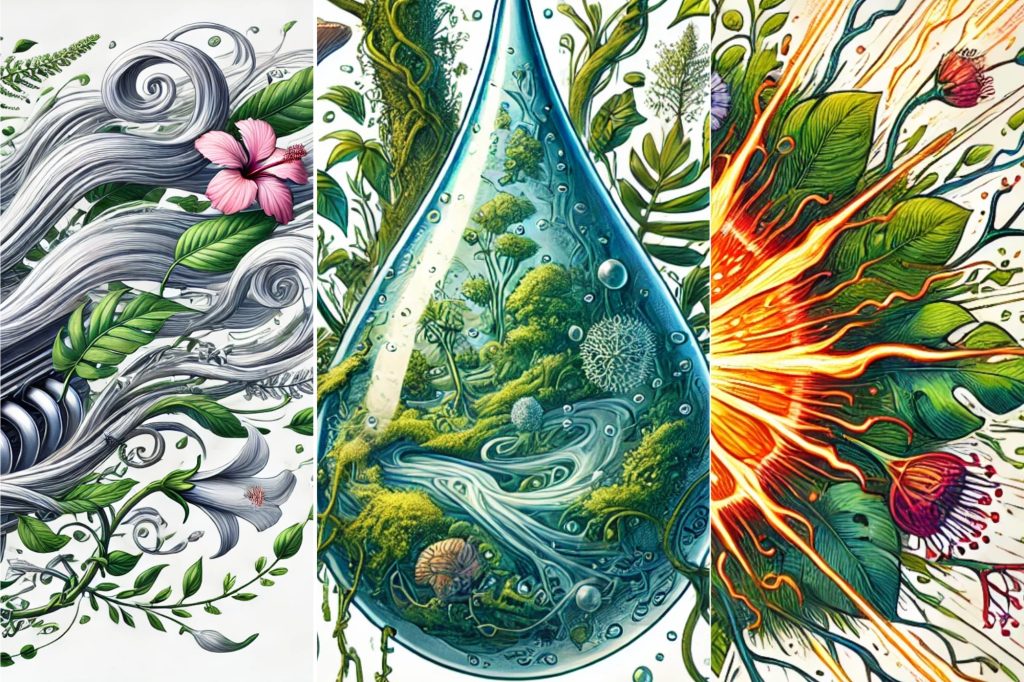Chapter 2: Air, Fuel, Spark

Every high-performance engine relies on three critical ingredients: air, fuel, and spark. Without them, you don’t get combustion, you don’t get torque, and you certainly don’t get movement. But what if we told you the same principles apply to plants?
Plants don’t burn gasoline, but they do something even more elegant: they harvest light, carbon dioxide, and water to generate the energy needed to grow, adapt, and thrive. In essence, plants operate like ultra-efficient combustion engines – just powered by sunlight instead of fossil fuel.
Let’s take a closer look at this botanical blueprint.
Air = Carbon Dioxide
In an internal combustion engine, oxygen from the air is essential for burning fuel. In plants, carbon dioxide (CO₂) is the air component, and instead of combustion, it enters a process called photosynthesis.
CO₂ is the raw material plants use to build all their internal structures. It provides the carbon backbone for sugars, amino acids, fatty acids, and every other organic molecule that plants make. In fact, nearly all of a plant’s biomass originates from this invisible gas in the air.
Without CO₂, there is no metabolism. No leaves, no roots, no growth.
Fuel = Water
In cars, fuel combusts to release chemical energy. In plants, the “fuel” is water, pulled up from the soil by the roots and transported through xylem to the leaves. Inside specialized engine compartments – namely the chloroplasts – this water is split apart (in our perspective, it’s depressurized but the classical description is ‘split’ so we’ll roll with that) during the light-dependent reactions of photosynthesis.
This process liberates electrons and hydrogen ions and produces oxygen as a byproduct. Those electrons and protons are then used to generate the energy molecules ATP and NADPH – the equivalent of high-octane fuel in the plant world.
Water isn’t just along for the ride, it’s fundamental to the ignition process.
Spark = Sunlight
Every combustion engine needs ignition. In cars, that spark comes from a plug. In plants, the spark is sunlight – specifically, photosynthetically active radiation (PAR).
Sunlight energizes chlorophyll and other pigments, initiating the electron transfer reactions that drive photosynthesis. This is the spark that sets everything in motion, transforming air (CO₂) and fuel (water) into primary and secondary metabolites – the horsepower and torque of plant growth.
This energy conversion isn’t metaphorical. It’s literal, measurable, and finely tuned by millions of years of evolutionary engineering.
Photosynthetic Horsepower
In a vehicle, horsepower and torque are tangible outcomes of combustion. In plants, we see those outputs in the form of sugars, amino acids, fatty acids, alkaloids, terpenes, and countless other compounds.
Primary metabolites like sugars and proteins form the basis of growth and reproduction.
Secondary metabolites like flavonoids and terpenoids allow plants to defend, attract, signal, and adapt.
These biochemical products represent the energy captured and stored by the plant engine. And just like a car’s performance depends on optimal ratios of air, fuel, and spark, plant productivity hinges on the same balance.
Tuning the Ratios
High-performance engines rely on precision tuning. Too much fuel and not enough air? You get inefficiency. Too much spark without enough fuel? You get misfires.
The same goes for plants.
A bright, sunny day means more spark – but without the right amount of fuel or air, extra spark ends up being counter-productive.
Extra CO₂ won’t help if spark and fuel are the limiting factors for performance.
Extra fuel, just like extra spark, can be counter-productive if the ratios are off.
Plants are constantly adjusting their own air-fuel-spark ratios, using internal feedback systems to optimize performance. Every elemental and non-elemental component of the plant engine is built on top of this foundation.
The Takeaway
Plants, like engines, need air, fuel, and spark to run. But unlike engines, they build themselves from the very materials they process. They don’t just use energy – they store it, convert it, and turn it into complex molecular architectures.
Understanding this triad – CO₂, water, and sunlight – is the key to unlocking plant performance.
Next up: Nitrogen – The Engine Mount That Holds Photosynthesis Together.

